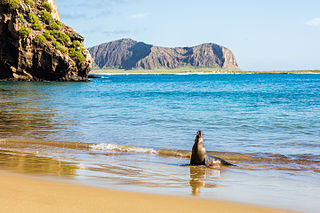
The Galápagos Islands are an archipelago of volcanic islands in the Eastern Pacific, located around the Equator 900 km (560 mi) west of the mainland of South America. They form the Galápagos Province of the Republic of Ecuador, with a population of slightly over 33,000 (2020). The province is divided into the cantons of San Cristóbal, Santa Cruz, and Isabela, the three most populated islands in the chain. The Galápagos are famous for their large number of endemic species, which were studied by Charles Darwin in the 1830s and inspired his theory of evolution by means of natural selection. All of these islands are protected as part of Ecuador's Galápagos National Park and Marine Reserve.

The Galápagos Islands xeric scrub, also known as the Galápagos Islands scrubland mosaic, is a terrestrial deserts and xeric shrublands ecoregion that covers the Galápagos Islands. The Galápagos Islands are volcanic in origin, and remote from continents and other islands. The ecoregion is well known for its unique endemic species, including giant tortoises, birds, and marine iguanas, which evolved in isolation to adapt to islands' environments.

Rábida or Rabida Island is one of the Galápagos Islands. It is 5 km2 (1.9 sq mi) in area.

Santa Cruz Island, also known as Indefatigable Island and by other names, is the most populous and second-largest island in the Galápagos Islands, Ecuador. Situated in the middle of the group, Santa Cruz is a shield volcano with an area of 986 km2 (381 sq mi) and a maximum altitude of 864 m (2,835 ft). The seat of Santa Cruz Canton is Puerto Ayora on Santa Cruz. The island's total population is around 18,000 with those living in smaller villages chiefly working in agriculture and cattle raising.
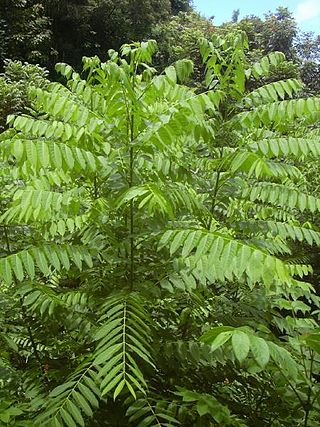
Cedrela odorata, commonly known as Spanish cedar, Cuban cedar, or cedro in Spanish, is a commercially important species of tree in the chinaberry family, Meliaceae native to the Neotropics.
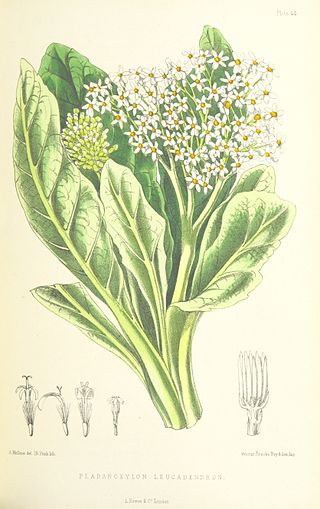
Pladaroxylon is a genus of trees in the tribe Senecioneae within the family Asteraceae.
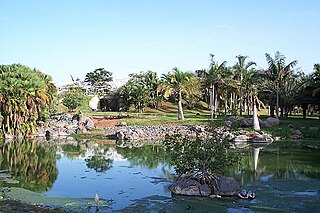
The Palmetum of Santa Cruz de Tenerife is a botanical garden of 120,000 m2 specialized in palms (Arecaceae). It is an artificial hill, with views of the ocean, located in Santa Cruz de Tenerife, Canary Islands, Spain. The gardens include a large system of waterfalls, streams and ponds, a museum dedicated to palms, and a display shade house. The project was started in 1995 on a former landfill and only opened to the public in 2014. The valuable palm collection gathers about 600 species of palms and it is focused on the ones native to world islands. Trees and shrubs of other plant families are also displayed, organised in "biogeographical sections". All gardens are maintained with no pesticides and no fertilizers, different species of wild birds are easily seen in the palmetum.
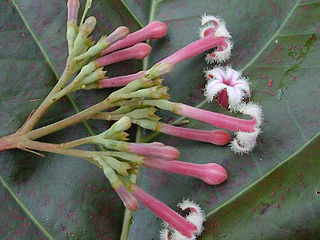
Cinchona pubescens, also known as red cinchona and quina (Kina), is native to Central and South America. It is known as a medicinal plant for its bark's high quinine content- and has similar uses to C. officinalis in the production of quinine, most famously used for treatment of malaria.
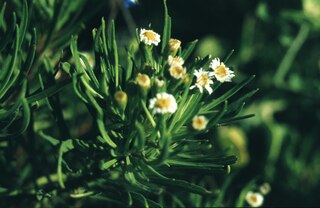
Scalesia affinis is a species of flowering plant in the family Asteraceae. It is endemic to the Galápagos Islands, Ecuador.

The small tree finch is a bird species belonging to the Darwin's finch group within the tanager family Thraupidae. It has a grasping beak with curved culmens. Its natural habitats are subtropical or tropical dry forests and subtropical or tropical dry shrubland. During the non-breeding season it is known to form large groups with small ground-finches.

The medium tree finch is a critically endangered species of bird in the Darwin's finch group of the tanager family Thraupidae. It is endemic to the Galápagos Islands where it is only found on Floreana Island. Its name is derived from the fact that the bird's beak is intermediate in size between that of the small tree finch and the large tree finch. Because it has a very small range on a single island, and because of the introduction of a parasitic fly which kills the nestlings, the International Union for Conservation of Nature has rated the medium tree finch as "critically endangered".

The Galápagos mockingbird is a species of bird in the family Mimidae. It is endemic to the Galápagos Islands, Ecuador.
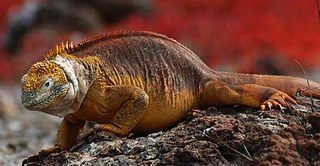
The Galápagos land iguana is a very large species of lizard in the family Iguanidae, and one of three species of the genus Conolophus. It is endemic to the Galápagos Islands off of Ecuador's Pacific coast, inhabiting the dry lowlands of Fernandina, Isabela, Santa Cruz, North Seymour, Baltra, and South Plaza islands.
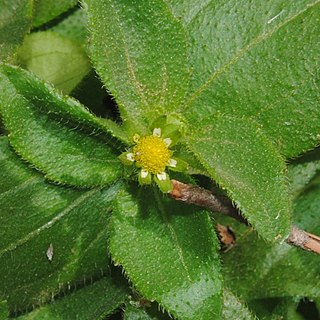
Jaegeria is a genus of flowering plants in the family Asteraceae found from Mexico to South America. The name commemorates Georg Friedrich von Jaeger.
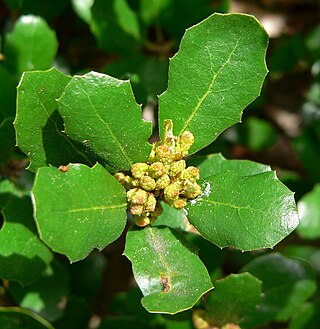
Quercus pacifica is a species of oak known by the common names island scrub oak, Channel Island scrub oak, and Pacific oak.

Scalesia pedunculata is a flowering plant species in the family Asteraceae, growing to a slender tree, and found in dense stands on the humid windward coasts of the islands of Santa Cruz, San Cristobal, Santiago and Floreana in the Galapagos Islands. The Galapagos archipelago lies in the southeast trade wind zone, so that climate and weather are dominated by the moisture-bearing trade winds and the topography of the islands. In general, the windward sides of the islands have a much higher precipitation than the leeward sides. Scalesia pedunculata is regarded as vulnerable because of human encroachment, invasive introduced plant species such as Cedrela odorata and Psidium guajava, and grazing by introduced goats. Fires and cutting for fuel are also contributory problems, though the tree's wood is soft, with a large, pithy centre.

William Alexander Stables was a Scottish botanist and naturalist who collected spermatophytes and pteridophytes sporadically in Great Britain and Ireland between 1832 and 1862, with the odd specimen as late as 1882. He was the son of Alexander Stables, factor for Lord Cawdor, and later himself became factor. He was a member of the Botanical Society of Edinburgh and collected extensively for a proposed Flora of Moray in the north of Scotland. In collecting he was often associated with Charles Bailey and William Lowndes Notcutt.
Cerro Pajas is an inactive volcano located in the south of Floreana Island in the Galápagos Islands, Ecuador. It is the highest peak on Floreana, with a maximum elevation of 640 meters above sea level.
Cora galapagoensis is a species of basidiolichen in the family Hygrophoraceae. It is Endemic to the Galápagos Islands, where it grows as an epiphyte on branches and trunks, usually in close association with other lichens and bryophytes. It was formally described as a new species in 2017 by Manuela Dal-Forno, Frank Bungartz, and Robert Lücking. It is a fairly common species in its range, and has been recorded from Isabela, Santa Cruz and Santiago islands. Preferred habitats include Miconia shrublands, secondary forests of Cinchona pubescens and Psidium guajava, and forests of Persea americana (avocado) and Scalesia pedunculata. The lichen can form colonies over 1 m (3.3 ft) broad with closely adjoining (imbricate) lobes
Usnea subcomplecta is a species of fruticose lichen in the family Parmeliaceae. It is found in the Galápagos Islands. It is characterized by its flaccid branches, blackened trunk, and pruinose cortex surface.

















